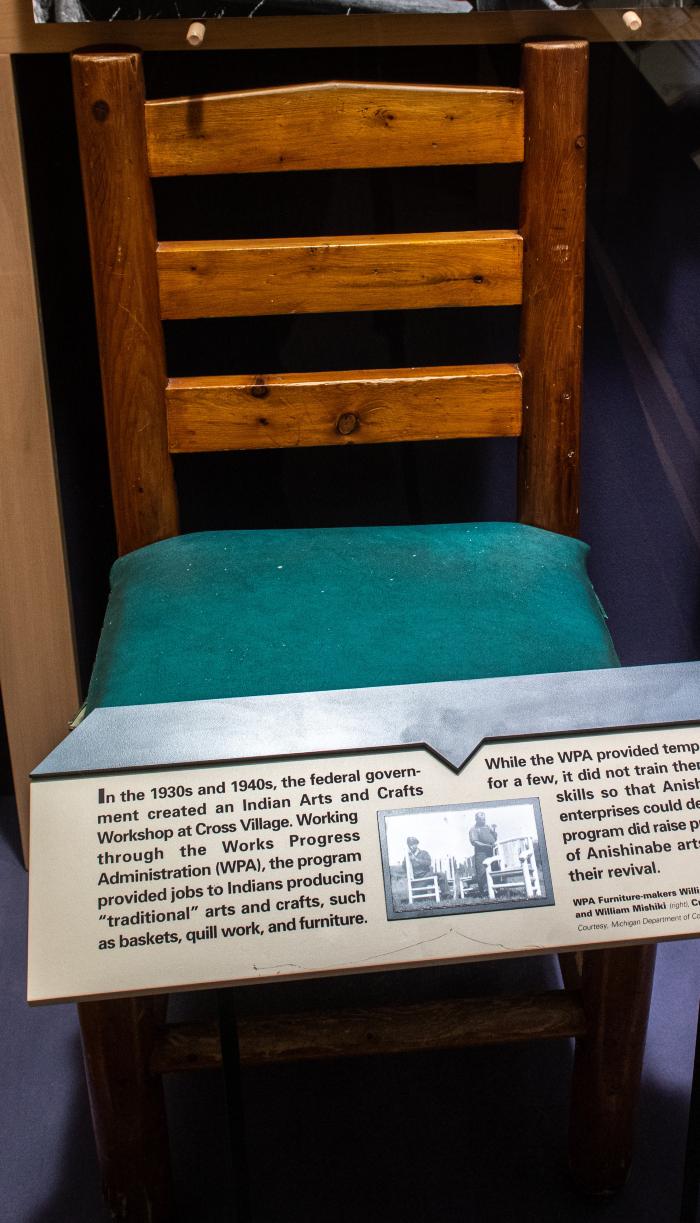Comments and Tags
Be the first to comment on this item!
Furniture ➔ Chair
Identifier:
1992.16.6Description:
Wooden chair made between the years of 1938 and 1941 as a result of the (MIHP) Michigan Indian Handicraft Project, which was a (WPA) Work Projects Administration program. This program was developed as one of the New Deal programs created under Roosevelt. These programs were created with the intention of providing aid to communities after the Great Depression.
The MIHP program was the reason this chair and others like it were produced in Cross Village as a way for Ottawa crafters in the area to make an income by utilizing traditional skills and adapting them for a wider, non-indigenous market like tourism shops. Unfortunately, it did fail since there wasn't any business training for the Indigenous merchants, and the people in charge were non-Native and not part of the community. This left the Indigenous crafters of Cross Village unable to support themselves economically from this program alone.
Date:
1938 – 1941Materials:
WoodDimensions:
35.5" h 18" w 19" dCurrent Location Status:
In StorageCollection Tier:
Tier 2Source:
Gift Of Dept. Of Natural Resources, State Of Michigan Ralph A. Macmullan Conference Center 4/6/1992Exhibits/Programs:
Anishinabek: The People of this Place (1995 – 2025)Anishinaabek: The Original People of This Place (after 2026)
Redesign of the Anishinabek: The People of this Place exhibit. Ideas for potential artifacts.
Related Entities:
Works Progress Administration (creator)Alternate names: W.P.A., Work Projects Administration, WPA
The Works Progress Administration (known also as the W.P.A. or WPA, and renamed the Work Projects Administration in 1939) was a federal program developed in response to the widespread unemployment and economic need people in the United States were experiencing during the Great Depression. The goal of the W.P.A. was to provide one paid job to each household affected by long-term unemployment, thereby replacing a direct-relief model of federal aid with a work-relief model. The program was established on May 6, 1935 and was terminated in 1943 due to low unemployment rates caused by the onset of World War II.
A 1939 pamphlet Questions and Answers on the WPA describes a W.P.A. project as “any useful public work on which the Federal Government and some tax-supported public body have agreed to cooperate, through the WPA, in order to provide work for the needy unemployed. The project is a community or State enterprise which the WPA helps to carry out; the completed project belongs to the community or State.” The pamphlet further specifies that projects should be “on public property,” “socially useful,” and “not be a part of the regular work of the sponsoring agency, such as should be wholly financed out of its own regular funds.”
The way the W.P.A. worked in most cases was that state and local government sponsors initiated and planned projects that were submitted to W.P.A. administrators for approval. Once a project was approved, sponsors employed workers (skilled or unskilled) whose wages were paid by the W.P.A.; land, materials and equipment were funded/supplied by the sponsors. There were, however, some nationwide infrastructure projects that were sponsored and largely funded by the W.P.A.’s Division of Engineering and Construction.
The W.P.A. was a massive program, employing 3,334,594 people at its peak in November 1938, with many subdivisions that focused on different tasks and types of projects over the life of the program. One of the most conspicuous components of the W.P.A. was collectively known as Federal Project Number One; it consisted of five different parts: the Federal Art Project, the Federal Music Project, the Federal Theatre Project, the Federal Writers’ Project, and the Historical Records Survey.
[This description of the W.P.A. is a work-in-progress. More details are forthcoming.] Ralph A. MacMullan Conference Center (donor)
